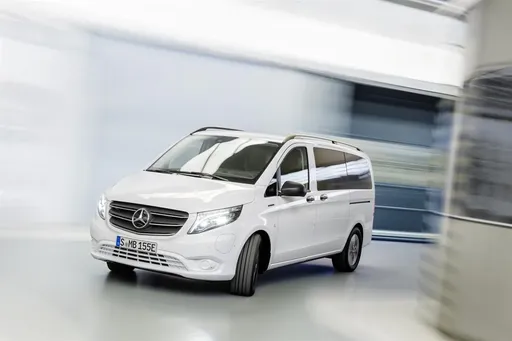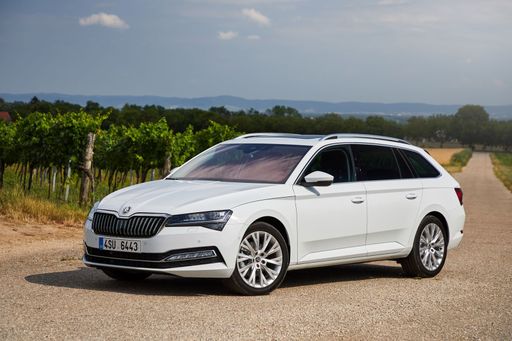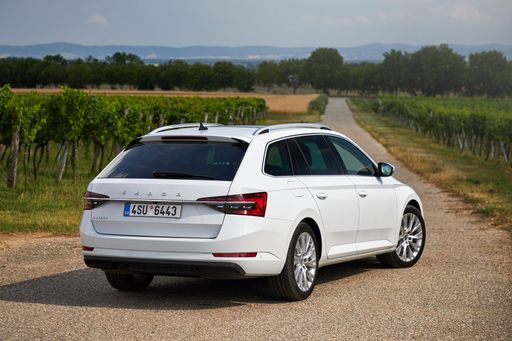Mercedes Vito Bus VS Skoda Superb Combi – Specs, Efficiency & Price Comparison
Which model is the better choice – the Mercedes Vito Bus or the Skoda Superb Combi? We compare performance (237 HP vs 265 HP), boot capacity (1390 L vs 690 L), efficiency (26.70 kWh6.70 L vs 0.40 L), and of course, the price (36300 £ vs 35200 £).
Find out now which car fits your needs better!
The Mercedes Vito Bus (Bus) is powered by a Diesel, Electric or Petrol engine and comes with a Manuel or Automatic transmission. In comparison, the Skoda Superb Combi (Estate) features a Petrol MHEV, Diesel, Petrol or Plugin Hybrid engine and a Automatic gearbox.
When it comes to boot capacity, the Mercedes Vito Bus offers 1390 L, while the Skoda Superb Combi provides 690 L – depending on what matters most to you. If you’re looking for more power, you’ll need to decide whether the 237 HP of the Mercedes Vito Bus or the 265 HP of the Skoda Superb Combi suits your needs better.
There are also differences in efficiency: 26.70 kWh6.70 L vs 0.40 L. In terms of price, the Mercedes Vito Bus starts at 36300 £, while the Skoda Superb Combi is available from 35200 £.
Compare all the key specs now and find out which model fits your lifestyle best!
In the realm of versatile family transporters, the Mercedes Vito Bus and Skoda Superb Combi stand out with distinct merits, catering to different needs. The Mercedes Vito Bus shines with its ample space and robust build, making it ideal for those who prioritize capacity and durability. Meanwhile, the Skoda Superb Combi offers a more refined ride and luxurious interior appointments, appealing to those who seek a balance of efficiency and comfort in their everyday journeys.
Mercedes Vito Bus
The Mercedes-Benz Vito Bus offers a versatile solution for those in need of spacious and comfortable group transportation. Its refined interior is designed to enhance passenger comfort, making it ideal for both business and leisure travel. With a focus on safety and efficiency, it provides a reliable driving experience that aligns with the high standards expected of the Mercedes-Benz brand.
details
Skoda Superb Combi
The Škoda Superb Combi combines practicality and elegance, making it a popular choice for families and professionals alike. Its spacious interior offers exceptional comfort and ample storage, suitable for long journeys and everyday errands. Additionally, the refined design and advanced technology features ensure a sophisticated driving experience.
details @ Skoda Presse Deutschland
@ Skoda Presse Deutschland
 @ Skoda Presse Deutschland
@ Skoda Presse Deutschland
A Clash of Utility and Performance: Mercedes Vito Bus vs Skoda Superb Combi
When it comes to versatile family and business transport, two European contenders stand out: the Mercedes Vito Bus and the Skoda Superb Combi. Each brings distinctive qualities to cater to different needs, from passenger capacity to engine efficiency. Let's dive into the specifics of these two automotive titans.
Power and Performance
The 2024 Mercedes Vito Bus offers a diverse range of engines, with diesel options varying from 136 to 237 HP, and a powerful electric engine as well. The diesel variants come equipped with either a manual or automatic gearbox, ensuring a choice for every driving preference. With a torque range of 330 to 500 Nm, the Vito Bus is designed to deliver robust performance, even when fully loaded.
On the other hand, the Skoda Superb Combi comes with a variety of engine types including petrol, diesel, and a plug-in hybrid, offering a promising balance between power and efficiency. Producing between 150 to 265 HP, with a strong 360 Nm torque available in the highest-spec engines, the Superb Combi promises a dynamic yet smooth driving experience. Notably, the hybrid model boasts an impressive electric range of up to 134 km.
Fuel Efficiency and Environmental Impact
Fuel consumption is an essential factor in vehicle selection. The diesel-driven Vito Bus has a consumption rate ranging between 6.7 to 7.8 L/100km, while the electric version offers an efficient 26.7 kWh/100km. With a CO2 efficiency class ranging from A to G, the electric models obviously lead the pack in environmental friendliness.
The Superb Combi showcases its efficiency, particularly within its plug-in hybrid version, recording a consumption of 0.4 L/100km for electric mode. Even the petrol and diesel variants display commendable efficiency, ranging from 4.9 to 7.9 L/100km. The CO2 emissions follow suit with a range spanning from 8 to 180 g/km, depending on the chosen powertrain.
Capacity and Comfort
The spaciousness of the Mercedes Vito Bus is undeniable, catering to up to 8 passengers with its generous interior. Featuring a trunk capacity between 580 to 1390 L, it easily accommodates extensive luggage or business equipment, making it a prime candidate for transport or fleet needs.
The Superb Combi, albeit smaller, excels being a practical and luxurious station wagon. It offers seating for five and a luggage capacity of up to 690 L, providing ample space for families and professionals alike. Its lower curb weight, 1575 to 1853 kg, also contributes to better agility compared to the Vito's substantial mass.
Styling and Dimensions
Style and dimensions are key considerations in choosing a vehicle. The Vito Bus provides an imposing presence with a length up to 5370 mm, emphasizing its commanding capability as a transporter. Conversely, the Superb Combi presents a sleeker and more refined shape with a length of 4902 mm, aimed at those who favor elegance with functionality.
In terms of width, the Vito measures 1928 mm while the Superb is slightly narrower at 1849 mm. Height differences are notable, with the Vito's 1890 mm emphasizing vertical space and the Superb's 1482 mm offering a more grounded look.
Conclusion
In comparing the Mercedes Vito Bus and the Skoda Superb Combi, the decision ultimately depends on the buyer's priorities. The Vito Bus shines in its capacity and power, ideal for large families or businesses requiring vast transport needs. Meanwhile, the Superb Combi impresses with its balance of performance, efficiency, and luxury, making it perfect for family and professional use alike.
For those seeking efficiency with substantial power, the Superb Combi might edge ahead; however, those prioritizing interior space and utility should consider the robust Vito. Ultimately, each vehicle holds its strengths in distinct arenas, pushing the envelope of what it means to offer practicality and innovation on the road.

|

|
|
|
|
Costs and Consumption |
|
|---|---|
|
Price
36300 - 59000 £
|
Price
35200 - 51000 £
|
|
Consumption L/100km
6.7 - 10 L
|
Consumption L/100km
0.4 - 7.9 L
|
|
Consumption kWh/100km
26.7 - 26.9 kWh
|
Consumption kWh/100km
-
|
|
Electric Range
248 - 370 km
|
Electric Range
124 - 134 km
|
|
Battery Capacity
60 - 90 kWh
|
Battery Capacity
19.70 kWh
|
|
co2
0 - 228 g/km
|
co2
8 - 180 g/km
|
|
Fuel tank capacity
57 - 70 L
|
Fuel tank capacity
45 - 66 L
|
Dimensions and Body |
|
|---|---|
|
Body Type
Bus
|
Body Type
Estate
|
|
Seats
8
|
Seats
5
|
|
Doors
4
|
Doors
5
|
|
Curb weight
2023 - 2739 kg
|
Curb weight
1575 - 1853 kg
|
|
Trunk capacity
580 - 1390 L
|
Trunk capacity
510 - 690 L
|
|
Length
4895 - 5370 mm
|
Length
4902 mm
|
|
Width
1928 mm
|
Width
1849 mm
|
|
Height
1890 mm
|
Height
1482 mm
|
|
Payload
726 - 1077 kg
|
Payload
497 - 584 kg
|
Engine and Performance |
|
|---|---|
|
Engine Type
Diesel, Electric, Petrol
|
Engine Type
Petrol MHEV, Diesel, Petrol, Plugin Hybrid
|
|
Transmission
Manuel, Automatic
|
Transmission
Automatic
|
|
Transmission Detail
Schaltgetriebe, Automatikgetriebe
|
Transmission Detail
Automat. Schaltgetriebe (Doppelkupplung)
|
|
Drive Type
Rear-Wheel Drive, All-Wheel Drive, Front-Wheel Drive
|
Drive Type
Front-Wheel Drive, All-Wheel Drive
|
|
Power HP
136 - 237 HP
|
Power HP
150 - 265 HP
|
|
Acceleration 0-100km/h
-
|
Acceleration 0-100km/h
5.7 - 9.3 s
|
|
Max Speed
140 km/h
|
Max Speed
220 - 250 km/h
|
|
Torque
330 - 500 Nm
|
Torque
250 - 400 Nm
|
|
Number of Cylinders
4
|
Number of Cylinders
4
|
|
Power kW
100 - 174 kW
|
Power kW
110 - 195 kW
|
|
Engine capacity
1950 - 1999 cm3
|
Engine capacity
1498 - 1984 cm3
|
General |
|
|---|---|
|
Model Year
2024
|
Model Year
2024
|
|
CO2 Efficiency Class
G, A
|
CO2 Efficiency Class
D, E, F, G, B
|
|
Brand
Mercedes-Benz
|
Brand
Skoda
|
Mercedes Vito Bus
The Mercedes Vito Bus: A Comprehensive Look at Innovation and Performance
In the automotive world, the Mercedes Vito Bus stands out as a versatile and reliable choice for those in need of a spacious and efficient mode of transport. With a reputation for engineering excellence, Mercedes-Benz has once again delivered with the latest versions of the Vito Bus. This article delves into the technical aspects, innovations, and what makes the Vito Bus a prime option in its segment.
Engine Power and Efficiency
The Mercedes Vito Bus offers a remarkable range of engine configurations, catering to both diesel and electric powertrains. The diesel models come with options ranging from 136 HP to a powerful 237 HP. The robust four-cylinder diesel engines are designed for efficiency, offering a range of fuel consumption figures from 6.7 L to 7.8 L per 100 kilometers, depending on the variant. Meanwhile, the electric eVito Tourer provides an impressive alternative with a power output of 204 HP and offers ranges of up to 371 kilometers on a single charge, making it a frontrunner in sustainable transportation solutions.
Transmission and Drivetrain Options
The Vito Bus is equipped with both manual and automatic transmission options, ensuring a drive tailored to user preferences. The 9G-TRONIC automatic gearbox is notable for its smooth transitions, enhancing the driving experience. Customers can choose between rear-wheel drive and the adaptable all-wheel drive system. The introduction of the eVito Tourer's front-wheel drive system further expands the versatility of the lineup, offering an electric alternative for urban and rural environments alike.
Interior Comfort and Practicality
The interior of the Vito Bus is designed with comfort and convenience in mind. Capable of seating up to eight passengers, the spacious cabin is ideal for family travel or business transportation. The Vito Bus offers three body lengths—kompakt, lang, and extralang—providing flexibility to accommodate different passenger and cargo requirements. The well-thought-out design ensures ample storage with trunk capacities ranging up to 1,390 liters in certain configurations.
Advanced Innovations
Mercedes-Benz has equipped the Vito Bus with a host of advanced technological features. The focus on safety is evident, with systems like Crosswind Assist and Attention Assist, ensuring greater control and alertness on the road. The eVito Tourer comes with the latest in electric vehicle technology, including efficient battery management systems that optimize range and performance.
Performance and Dynamics
The Vito Bus showcases impressive performance metrics across its variants. With a maximum torque ranging from 330 Nm to 500 Nm, the Vito Bus ensures a responsive and agile driving experience. The consistent build quality and dynamic chassis contribute to a pleasing ride, whether navigating city streets or cruising on the highway.
Conclusion
The Mercedes Vito Bus continues to be a leading choice for those looking for a reliable and performance-oriented vehicle. With its diverse range of engine options, innovative features, and versatile configurations, the Vito Bus meets the demands of both personal and professional transportation. The introduction of electric variants highlights Mercedes-Benz's commitment to sustainability without compromising on power or range. As the automotive industry continues to evolve, the Vito Bus exemplifies the blend of traditional excellence and forward-thinking innovation.
Skoda Superb Combi
The Skoda Superb Combi: A Blend of Elegance and Performance
The Skoda Superb Combi stands as a testament to the Czech manufacturer's prowess in combining practicality with stylish design. Offering a suite of advanced features and powerful engine options, it strikes a remarkable balance between efficiency, power, and technology. This estate model is perfect for those who seek an automobile that is both spacious and performance-driven.
Engine Options: Power Meets Efficiency
The Superb Combi offers a diverse range of engine choices, catering to varying needs of drivers. From the 1.5 TSI mHEV Petrol Mild-Hybrid to the robust 2.0 TDI SCR Diesel with All-Wheel Drive, there's a powertrain to suit every preference. The petrol variants provide up to 265 PS, ensuring a dynamic driving experience, whereas the plug-in hybrid model emphasises efficiency with a stunning consumption rate of 0.4 L/100km and an electric range reaching up to 134 km.
Innovative Features: A Technological Marvel
Equipped with the latest in automotive technology, the Superb Combi makes driving both a luxurious and innovative experience. Features such as the automated dual-clutch gearbox enhance the driving feel, offering smooth and responsive shifts. The inclusion of mild-hybrid technology in select models shows Skoda's commitment to sustainability without compromising on performance.
Design and Comfort: Spacious Elegance
With dimensions that emphasise interior space, the Skoda Superb Combi is designed to offer maximum comfort for all passengers. The generous boot capacity ranges from 510 to 690 litres, making it perfect for family trips or business journeys with ample luggage. Comfort is further enhanced by high-quality interior furnishings and intuitive infotainment systems that keep everyone entertained and informed.
Safety and Driver Assistance: Unwavering Protection
Skoda doesn't compromise on safety, equipping the Superb Combi with advanced driver assistance systems. From adaptive cruise control to lane keep assist, the vehicle ensures a confident driving experience. The robust body structure coupled with a comprehensive set of airbags and stability control systems work together to provide maximum safety on every ride.
Conclusion: A Premium Estate with Versatility
The Skoda Superb Combi is a remarkable car that expertly combines versatility with luxury and performance. Whether driven on long road trips or through city traffic, its blend of technology, comfort, and practicality ensures it excels in all conditions. It stands out as an excellent choice for those who require space without sacrificing the thrill of driving.
The prices and data displayed are estimates based on German list prices and may vary by country. This information is not legally binding.
